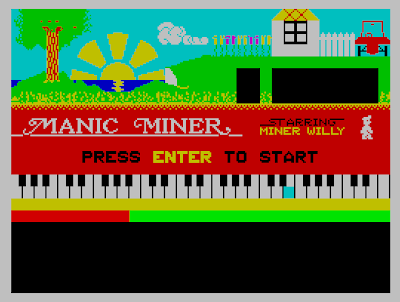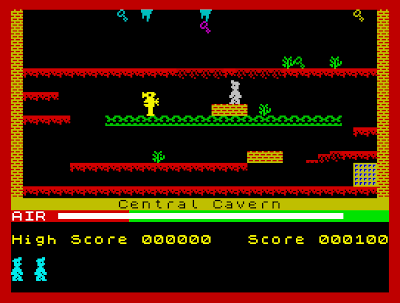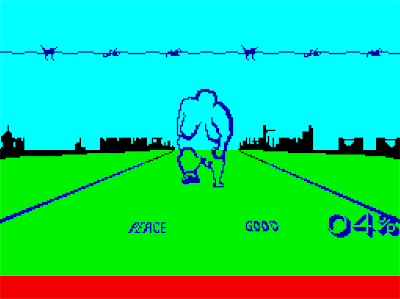Feb 16, 2017
Eye^Game^Candy: Where Time Stood Still
Jun 25, 2014
Kaptain Brawe II singing for Viggo on a ZX Spectrum
Hello reader, here are three Kickstarter campaigns that deserve our love:
Kaptain Brawe 2: A Space Travesty
A Song for Viggo
The Story of the ZX Spectrum in Pixels
Aug 1, 2011
The Mark Jones Interview
Which games you've worked on make you feel the proudest?
Related @ Gnome's Lair:
Dec 3, 2010
Eye^Game^Candy: Alien 8
Nov 26, 2010
Being Creative with a Sinclair ZX Spectrum
Related @ Gnome's Lair:
Sep 29, 2010
Eye^Game^Candy: 3D Deathchase
Jul 15, 2010
Meet Manic Miner
It has come to my attention that the majority of this blog's brilliantly smart and generally gorgeous readers are not, in fact, European, meaning that they most probably remain unaware of the classic platform game that was Manic Miner. This situation is of course unacceptable, as Manic Miner is my all-time favourite game of the genre and easily sits among my top 10 games ever. It also is a game everyone must play; preferably on the platform it was created for: the ZX Spectrum.
Manic Miner, the prequel to Jet Set Willy, in what can only be described as a really brief history lesson, was developed for the 8-bit ZX Spectrum back in 1983 by teen programmer and cult-icon Matthew Smith and published by Bug Byte, only to be later re-released by Software Projects (Smith's new company) and eventually get itself (officially) ported on almost everything that could load games, including the C64, the Amiga, the Oric-1, the Z88, the Amstrad CPC, the Dragon 32, Nintendo's GBA and even the Sam Coupe. Interestingly, most of these ports added new levels, new enemies and new ideas, which have finally been compiled into Manic Miner: In the Lost Levels; the best Nintendo DS game ever. But, as is customary, I digress.
The game itself was inspired by Bill Hogue's Miner 2049er and was a single-screen platform game, that saw Willy, Manic Miner's protagonist, jump over surreal enemies and deadly pits, collect keys and avoid a variety of traps in order to beat 20 incredibly difficult caverns (levels). And when I say difficult, I really mean it. I've been playing the Speccy version of Miner Willy (without cheats or emulator-based saves; yes, I do have my hardcore gaming fetishes too) for over 20 years and have reached the final level only twice. I can achieve the perfect playthrough of the first 10 caverns without even thinking, mind, but still can't beat the game with the meager three lives provided.
But, why do I persevere with it? Simple. The enjoyment provided is unequaled. Manic Miner, you see, is a masterfully crafted platformer; a true masterpiece in game design. It demands pixel-perfect precision and swift pattern recognition, yet is never unfair, boring or confusing. Each level is entirely unique both in mechanics and in appearance, utterly demented, has a ridiculous name ranging from Attack of the Mutant Telephones to The Menagerie, and features its very own assortment of enemies. And yes, the enemies have to be seen to be believed, as the game attacks gamers with an outrageous selection of baddies that includes mutant telephones, seals, Ewoks, Pac-Men, killer toilettes, Kong Beasts, penguins, safes and (much) more.
Then again, words can't do Manic Miner justice. You simply have to play it. Preferably with a Kempston-compatible joystick.
Find out more about Manic Miner over at Wikipedia, MobyGames, and of course World of Spectrum, where you can also download the game or even play an online emulated version. What's more, there are quite a few related Gnome's Lair posts that will definitely interest you:
Jan 28, 2010
The Free (!) ZX Spectrum Book - 1982 to 199x
 When I first heard about the ZX Spectrum book - 1982 to 199x by Hiive books I was decidedly thrilled. I also decided to grab a copy and miserably failed. This apparently brilliant book, you see, swiftly sold out and was soon replaced by a luxuriant hardback edition, that was way to expensive for me. Thankfully, Hiive, being the busy indie little publishing house it is, went on and published the The Commodore 64 Book - 1982 to 199x, which I immediately grabbed. And it was brilliant. Both in content and in layout.
When I first heard about the ZX Spectrum book - 1982 to 199x by Hiive books I was decidedly thrilled. I also decided to grab a copy and miserably failed. This apparently brilliant book, you see, swiftly sold out and was soon replaced by a luxuriant hardback edition, that was way to expensive for me. Thankfully, Hiive, being the busy indie little publishing house it is, went on and published the The Commodore 64 Book - 1982 to 199x, which I immediately grabbed. And it was brilliant. Both in content and in layout.This of course made things worse in a weird way that had everything to do with me not being able to read the Speccy book. I even emailed Hiive books and asked them to make a digital copy of the thing available for purchase. Being the nice fellows they are, they said they'd look into it.
Obviously, they didn't, as they went on and released the whole book for free. Yes! Exactly as I tweeted (?) almost a month ago (did feel the subject needed a proper post of its own though), the ZX Spectrum Book - 1982 to 199x can now be downloaded for free over at the World of Spectrum in its complete 258 pages glory. And, yes, it's as good as I imagined. Even better really, what with the introduction by Sir Clive himself, the excellent quality of the game presentations and the tons of info. Here are a couple pages to wet your appetite:
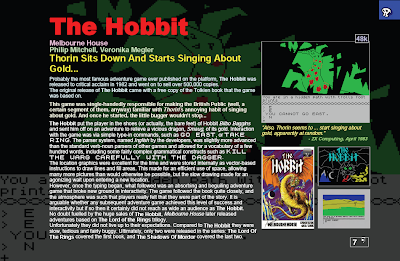
 Related @ Gnome's Lair:
Related @ Gnome's Lair:Jan 25, 2010
Deus Ex Machina by Automata
 You could experience Automata's 1984 magnum opus by downloading the game's tape images and synchable soundtrack from the WoS archive. You could experience it by watching a complete playthrough on YouTube. You could even experience it on a proper ZX Spectrum installed next to a tape recorder running an original copy of the game. But, no matter how, the truth is you really have to experience Deus Ex Machina. Or at least find out more about it. It's such a unique and utterly unsurpassed piece of interactive entertainment (?) nobody can afford to ignore it.
You could experience Automata's 1984 magnum opus by downloading the game's tape images and synchable soundtrack from the WoS archive. You could experience it by watching a complete playthrough on YouTube. You could even experience it on a proper ZX Spectrum installed next to a tape recorder running an original copy of the game. But, no matter how, the truth is you really have to experience Deus Ex Machina. Or at least find out more about it. It's such a unique and utterly unsurpassed piece of interactive entertainment (?) nobody can afford to ignore it.Then, you have to head over to the brilliant DeusExMachina2.com website, where you will be able to find out everything you can imagine about this early 8-bit masterpiece. Expect tons of artwork, videos, reviews, interviews, photos, storyboards and, shockingly, more.
Related @ Gnome's Lair:
Mar 5, 2009
If I had a PS3 and a copy of LBP...
Bombarding Alan Sugar with Sinclair microdrives... Ahh, brilliant, just brilliant!
Feb 23, 2009
Spectrum of Beauty (a tiny digital exhibition)
 Anyone interested in game design will tell you that graphics and sound should be complimentary to the way a game plays. That gameplay comes first. That, despite the enduring success of Dragon's Lair, the essence of gaming somehow lies somewhere beyond the realm of the visual arts. That there is to it more than mere eye candy, impressive gfx or a thundering soundtrack.
Anyone interested in game design will tell you that graphics and sound should be complimentary to the way a game plays. That gameplay comes first. That, despite the enduring success of Dragon's Lair, the essence of gaming somehow lies somewhere beyond the realm of the visual arts. That there is to it more than mere eye candy, impressive gfx or a thundering soundtrack.These people would of course be right. Well, mostly really.
On the other hand, the vast majority of game creators, and that would include both graphics specialists and any kind of visual artist working on games, would fail to see that the visual quality of a game, its beauty, is actually platform and technology independent. They can't, you see, seem to grasp the simple idea that hardware imposed limitations can actually inspire artistic innovation and show off ones talent, and keep asking for more power to express themselves. They stubbornly ignore the fact that the abstract beauty of Kandinsky is far more interesting than the latest photorealistic 3D depiction of the Death Star and keep striving for realism; not art.
To actually illustrate the point that visually beautiful games can be created on the humblest of platforms, I've decided to present you with some glorious screens the ZX Spectrum managed to display, using nothing more than its meager (and quite frankly odd) 15 colours on its tiny 256 x 192 display, while simultaneously battling with the computer's inherent colour clash problems. And no, I'm not referring to anything technically impressive the Speccy demoscene has managed to force out of the hardware.
(click on the following screenshots to see them properly)
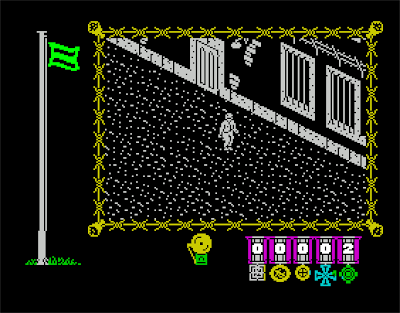 Denton Designs, The Great Escape, 1986, WoS
Denton Designs, The Great Escape, 1986, WoS Sandy White, Ant Attack, 1983, WoS
Sandy White, Ant Attack, 1983, WoS Microsphere, Back to Skool, 1985, WoS
Microsphere, Back to Skool, 1985, WoSRelated @ Gnome's Lair:
Feb 12, 2009
Retro Abomination: Super Gran
 So, after buying that lovely Spectrum, I finally got to properly explore bits of the amazing Hobbit text adventure, got impressed by Winter Sports, tried solving Waxworks, avoided more than a few sub-par arcade conversions and -eventually- decided to give Tynesoft's Super Gran a try. It is, you see, an arcade game based on the 80s kids friendly TV series of the same name; a series I fondly, though admittedly vaguely, still seem to remember.
So, after buying that lovely Spectrum, I finally got to properly explore bits of the amazing Hobbit text adventure, got impressed by Winter Sports, tried solving Waxworks, avoided more than a few sub-par arcade conversions and -eventually- decided to give Tynesoft's Super Gran a try. It is, you see, an arcade game based on the 80s kids friendly TV series of the same name; a series I fondly, though admittedly vaguely, still seem to remember.The first thing that actually struck me after loading the game was just how dreadful everything looked. I mean, come on Tynesoft, we all know the Speccy is a graphically limited machine, but at least it always managed to output some decently detailed graphics that didn't horribly flicker. Not so with Super Gran, despite it being a 1985 release. Everything is ridiculously blocky and badly drawn, moves sluggishly and flickers like there's no tomorrow. What's more, the only redeeming feature of the thing's graphics, the admittedly decent looking sprites' size, only contributes in reducing the game's playability and making for a horribly crammed playing area.
 Then again, graphics don't make a game, do they? Of course they don't and that's where Super Gran spectacularly fails. The controls are shockingly unresponsive, the first three levels (ranging from a horrid shmup-like thing to a top down racing affair) I managed to see are dull, short and ridiculously tough and -adding insult to injury- the game has even managed to age horribly, making sure nobody will actually dare to find out if it really sported the 10 levels/screens the devs promised. Then again, the first level should be all you need subject yourselves too. It impressively manages to encompass all that is wrong with Super Gran in just one screen!
Then again, graphics don't make a game, do they? Of course they don't and that's where Super Gran spectacularly fails. The controls are shockingly unresponsive, the first three levels (ranging from a horrid shmup-like thing to a top down racing affair) I managed to see are dull, short and ridiculously tough and -adding insult to injury- the game has even managed to age horribly, making sure nobody will actually dare to find out if it really sported the 10 levels/screens the devs promised. Then again, the first level should be all you need subject yourselves too. It impressively manages to encompass all that is wrong with Super Gran in just one screen!As for the sound, well, at least it can be easily turned off.
(Find out more about Super Gran and -god forbid- download a copy of the thing via World of Spectrum. It will be a most enlightening experience let me assure you.)
Related @ Gnome's Lair:
Jan 13, 2009
A ZX Spectrum + enters the Lair
 I've been craving for a ZX Spectrum for the better part of the last 20 years, but -as the above photo should have already made clear- the long wait is finally over. No more house visits to Speccy owning friends, no more emulation-only fun, no more begging, no more avoiding loading times or fiddling with interfaces. A lovely Sinclair ZX Spectrum + complete with tape recorder, joystick, joystick interface, manuals, an assortment of cables and an interesting selection of mainly obscure games has finally arrived, while more Speccy goodies are already on the way and The Hobbit has been sitting on my desk for more than a week. Oh, and so you know, this Spectrum is quite possibly the best 30 euros I've ever spent online. And no I shouldn't be posting this over at Retro Treasures.
I've been craving for a ZX Spectrum for the better part of the last 20 years, but -as the above photo should have already made clear- the long wait is finally over. No more house visits to Speccy owning friends, no more emulation-only fun, no more begging, no more avoiding loading times or fiddling with interfaces. A lovely Sinclair ZX Spectrum + complete with tape recorder, joystick, joystick interface, manuals, an assortment of cables and an interesting selection of mainly obscure games has finally arrived, while more Speccy goodies are already on the way and The Hobbit has been sitting on my desk for more than a week. Oh, and so you know, this Spectrum is quite possibly the best 30 euros I've ever spent online. And no I shouldn't be posting this over at Retro Treasures.What's truly weird throughout this long waiting period though, is the simple fact that I've always been a huge Spectrum gamer/fan, despite never actually owning a Spectrum. I have, you see, been emulating the thing on everything from the 16-bit Amiga, to my current PC, to my trusty Pocket PC and have also been constantly asking people to get their ancient 8-bits out of the closet. Then again, Manic Miner is among my top favourite games, Ultimate and Mr. Ritman are still being daily praised, dozens of text adventures have already been beaten, hundreds of reviews have been drooled upon and hours of arguing over Match Day II have been spent. So, well, hoorah for my new acquisition I guess! I can finally enjoy my fav games the way Sir Clive intended.
Also, with the added pleasure of the almost proper Plus keyboard, 8-bit interactive fiction will hopefully become a daily fetishistic practice. Let alone the fact that such keyboards have been know to turn simple gamers into creative people...
Related @ Gnome's Lair:
Jul 18, 2008
The Spectrum Games Bible 1982-2008
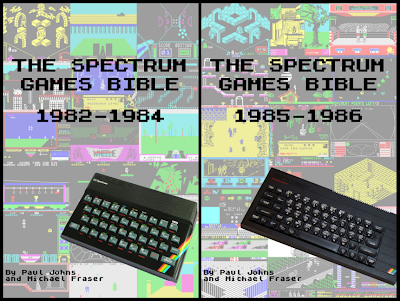 Having already missed the apparently excellent ZX Spectrum Book - 1982-19xx book, I'm more than excited to have been timely informed about the incredibly ambitious Spectrum Games Bible 1982-2008 project, that's already spanning two books and covering more than 500 games. What's more, at least four more books will soon be released, hopefully reviewing every game ever released for the gloriously humble Speccy. Now, that's what I call ambition. Possibly a worthy cause too. Well, almost. Anyway.
Having already missed the apparently excellent ZX Spectrum Book - 1982-19xx book, I'm more than excited to have been timely informed about the incredibly ambitious Spectrum Games Bible 1982-2008 project, that's already spanning two books and covering more than 500 games. What's more, at least four more books will soon be released, hopefully reviewing every game ever released for the gloriously humble Speccy. Now, that's what I call ambition. Possibly a worthy cause too. Well, almost. Anyway.To grab the extremely well priced first books (or their rather pricey colour counterparts) do yourselves a favour and follow this handily underlined link. Mind you, you can even contribute to the forthcoming volumes -this is most obviously a group project, you see- and, yes, actually get paid. Oh, oh, and for some free, online, high-score comparing ZX Spectrum gaming you have to give MySpeccy a try.
Related @ Gnome's Lair: re: Rex, the glory of Llamasoft, JSW: the patch, Vinyl Data and adventures on LPs
May 19, 2008
The Zenobi Software Loading Screens

 Zenobi Software, besides coming up with hundreds of excellent text-adventures, did also manage to provide ZX Spectrum gamers with some equally beautiful and brilliantly evocative loading screens. Just like the couple posted above really, and if you care for more (you should) do follow this artsy flickr link. You'll find quite a few slightly magnified Zenobi loading screens and I can guarantee there will soon be more. Well, after I get back from the island of Lesvos that is (hopefully some time next week).
Zenobi Software, besides coming up with hundreds of excellent text-adventures, did also manage to provide ZX Spectrum gamers with some equally beautiful and brilliantly evocative loading screens. Just like the couple posted above really, and if you care for more (you should) do follow this artsy flickr link. You'll find quite a few slightly magnified Zenobi loading screens and I can guarantee there will soon be more. Well, after I get back from the island of Lesvos that is (hopefully some time next week).Related @ Gnome's Lair: Rochdale Balrog Interview, the 2007 AGS Awards, Resonance screens, EGM issue #1
May 16, 2008
a few gnomish questions / The Balrog of Zenobi
 1. Tell us a bit about yourself, oh Balrog. Some info on the cat might be nice too.
1. Tell us a bit about yourself, oh Balrog. Some info on the cat might be nice too.2. Why -and more importantly, how- did you start Zenobi? Were you all alone in this, erm, adventure of sorts?
3. And the focus on text-adventures on the ZX Spectrum? How did you decide on that?
4. Weren't you afraid of actually competing against bigger software houses?
5. You've created a fair amount of admittedly brilliant, tough, inspired and generally hilarious adventures. Which ones are you favorites? Was there a certain way your games were designed? I mean, really, where did all this inspiration come from?
6. How did you come up with those intricate puzzles?
7. What about them weird names, settings, loading screens and stories?
8. Now, as Zenobi published quite a few games from a variety of authors/designers, could you give us some insight as to how this bit actually worked?
9. In retrospect, which would you say were the finest moments in/of Zenobi?
10. Why stop after the Atari ST games?
11. Any other platforms you developed for?
12. Oh, and do you still play games? Any thoughts on their current state?
13. Considering there is a strong Spectrum retro scene, a very lively interactive fiction scene and an obvious revival of the adventure genre, well, what does the future hold? More games? A book per-chance?
14. Finally, you do still feel the Zenobi love, don't you? Mind you, feel free to add anything else you think would be vaguely appropriate and/or titillating.
It was a dark rainy night and Balrog was slumped over a plate of mince & tatties when there was a gentle 'tap' on the kitchen door. "Bloody visitors .. and at this time of night as well!" growled Balrog as he flicked the errant pea(s) back on to his plate and shuffled off in the direction of the knock. "John Wilson ?" enquired the chubby-faced gent stood in the pouring rain. "Come in Tam .." grinned the Balrog and ushered the gent, and his companion, into the warmth of the kitchen. "How do you know me?" asked the gent. "Saw your picture in PCW when you were awarded the prize for completing 'The Ket Trilogy' smiled Balrog, flicking on the switch for the kettle and reaching under the worktop for some cups. "Tea or coffee and how many sugars ??"
So it was that 'Tartan Tam' encountered the Balrog for the first time ... a true story!!"
Related @ Gnome's Lair: Peter Favaro / Alter Ego interview, Gun Mute, Text is King, Rex on the ZX Spectrum
Feb 28, 2008
Rex and the ZX Spectrum militant ecology movement
 1988 was 20 years ago and I admittedly do feel a bit on the older side of mankind. Regardless. It's amazing that 20 years since the release of Rex for the ZX Spectrum video games with a strong environmental theme can be counted on one (very crippled) hand, whereas happily militaristic shooters where starry-eyed young gamers kill anything vaguely resembling an Arab are a dime a dozen. And to think that back then it was still actually cold in Antarctica... Oh, well, it must be this clampdown thingy again.
1988 was 20 years ago and I admittedly do feel a bit on the older side of mankind. Regardless. It's amazing that 20 years since the release of Rex for the ZX Spectrum video games with a strong environmental theme can be counted on one (very crippled) hand, whereas happily militaristic shooters where starry-eyed young gamers kill anything vaguely resembling an Arab are a dime a dozen. And to think that back then it was still actually cold in Antarctica... Oh, well, it must be this clampdown thingy again.Anyway. On to the game. On to Rex, the brilliant Speccy arcade platformer/shooter that, yes, you guessed it, was released back in 1988 by Martech Games to generally rave reviews. After all, massive Metroid-esque exploration-heavy action games, especially those that used both sides of a tape, weren't all that common for the humble Sinclair 8-bit.
 In Rex, dear readers, players assumed the role of the cunningly named Rex, a heavily armored anthropomorphic rhino with a certain passion for ecology, and set off to rid his home-planet from a huge polluting factory-tower-fortress big building thing. Actually, make that a huge, cavernous, impressively non-linear factory-tower-fortress building thing and you'll have managed a way more accurate description.
In Rex, dear readers, players assumed the role of the cunningly named Rex, a heavily armored anthropomorphic rhino with a certain passion for ecology, and set off to rid his home-planet from a huge polluting factory-tower-fortress big building thing. Actually, make that a huge, cavernous, impressively non-linear factory-tower-fortress building thing and you'll have managed a way more accurate description.Oh, and in order to survive said treacherous fortress thing players had to be more than skillful, as this was another traditionally difficult 8-bit game. To be fair though, Rex did provide with quite a few power-ups, occasionally a shield and some almost fairly placed respawn points, that actually did help. What's more, as the game was divided into two parts, there was a brilliant code system in place to help 'em poor gamers avoid playing the first bit all over again. Impressively, this code system even managed to pass on information regarding Rex's health/ammo/etc status.
As for the graphics, well, they were nice, colourful and detailed, and quite wisely designed to avoid as much colour-clash as possible. Sounds, on the other hand, were kept to a minimum few effects and obviously no music was featured.
The gameplay, what truly matters, of course was brilliant and immensely addictive. Otherwise, I guess, I wouldn't be battling my way through Rex all over again, especially on a pretty decent PC loaded with games and while ignoring a Wii...
 To legally play Rex, download its tape images, read relevant reviews and/or generally go for the complete Rex experience, I strongly suggest you click yourselves over to the excellent World of Spectrum website. Among other stuff you'll find tons of Rex reviews, maps, ads, previews and walkthroughs.
To legally play Rex, download its tape images, read relevant reviews and/or generally go for the complete Rex experience, I strongly suggest you click yourselves over to the excellent World of Spectrum website. Among other stuff you'll find tons of Rex reviews, maps, ads, previews and walkthroughs.Related @ Gnome's Lair: Mersey Remakes interview, Matthew Smith in FMV, Sensible Train Spotting, the Retro Gamer eMag
Jan 5, 2008
Matthew Smith gaming in Full Motion Video
Related @ Gnome's Lair: the Jet Set Willy patch, RGCD, Monty's Christmas Special, Lurking Horror retro review
Dec 13, 2007
The first video game patch in history. Well, probably.
Software Projects, the game's publishers, sensed that the sadism inherent in JSW would make for a great competition and thus a chance for some extra publicity, and knowing that the gamers of the era were hardcore 14 year olds, they merrily went on with their plan. The first one to find all of the JSW objects would win a helicopter ride and a case of champagne. The competition though, finally won by Ross Holman and Cameron Else, besides the publicity bit, did help bring forth 4 major bugs in the game and Software Projects decided to patch it. Probably for the first time in video gaming history and apparently to show they sort of cared.
- Moving an invisible object from the First Landing to The Hall (42183,11)
- Removing a killer object from the Conservatory Roof (60231,0),
- Changing a block in the Banyan Tree to a walk-through type (56876,4)
- The Attic bug fix Poke (59901,82).
Rewind the Jet Set Willy tape and load it using MERGE "", press Enter and start the tape. Once the loader program has been loaded you will get the 'OK' message on the screen and you should stop the tape. Now enter:
CLEAR 32767
LOAD "" CODE as direct commands and start the tape. After the main part of the program has loaded, enter the following as direct commands:
POKE 60231,0
POKE 42183,11
POKE 59901,82
POKE 56876,4
and your problems should be over. To start the new version of the game, enter GO TO 40.
Related @ Gnome's Lair: The Heroquest POKE, PDF Spectrum emulation bible, 3D Ant Attack, free online retro gaming
















